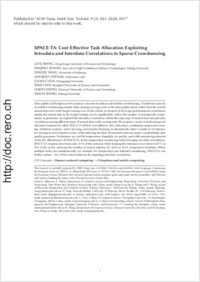SPACE-TA: cost-effective task allocation exploiting intradata and interdata correlations in sparse crowdsensing
- Wang, Leye Hong Kong University of Science and Technology, Hong Kong SAR, China
- Zhang, Daqing Key Lab of High Confidence Software Technologies, Peking University, Beijing, China
- Yang, Dingqi University of Fribourg, Fribourg, Switzerland
- Pathak, Animesh myKaarma Labs, CA, USA
- Chen, Chao Chongqing University, Chongqing, China
- Han, Xiao Shanghai University of Finance and Economics, Shanghai, China
- Xiong, Haoyi Missouri University of Science and Technology, MO, USA
- Wang, Yasha Peking University, Beijing, China
-
08.10.2017
Published in:
- ACM Trans. Intell. Syst. Technol.. - 2017, vol. 9, no. 2, p. 20:1–20:28
English
Data quality and budget are two primary concerns in urban-scale mobile crowdsensing. Traditional research on mobile crowdsensing mainly takes sensing coverage ratio as the data quality metric rather than the overall sensed data error in the target-sensing area. In this article, we propose to leverage spatiotemporal correlations among the sensed data in the target-sensing area to significantly reduce the number of sensing task assignments. In particular, we exploit both intradata correlations within the same type of sensed data and interdata correlations among different types of sensed data in the sensing task. We propose a novel crowdsensing task allocation framework called SPACE-TA (SPArse Cost-Effective Task Allocation), combining compressive sensing, statistical analysis, active learning, and transfer learning, to dynamically select a small set of subareas for sensing in each timeslot (cycle), while inferring the data of unsensed subareas under a probabilistic data quality guarantee. Evaluations on real-life temperature, humidity, air quality, and traffic monitoring datasets verify the effectiveness of SPACE-TA. In the temperature- monitoring task leveraging intradata correlations, SPACE-TA requires data from only 15.5% of the subareas while keeping the inference error below 0.25°C in 95% of the cycles, reducing the number of sensed subareas by 18.0% to 26.5% compared to baselines. When multiple tasks run simultaneously, for example, for temperature and humidity monitoring, SPACE-TA can further reduce ∼10% of the sensed subareas by exploiting interdata correlations.
- Faculty
- Faculté des sciences et de médecine
- Department
- Département d'Informatique
- Language
-
- English
- Classification
- Computer science and technology
- License
-
License undefined
- Identifiers
-
- RERO DOC 308932
- DOI 10.1145/3131671
- Persistent URL
- https://folia.unifr.ch/unifr/documents/306257
Statistics
Document views: 128
File downloads:
- pdf: 280
